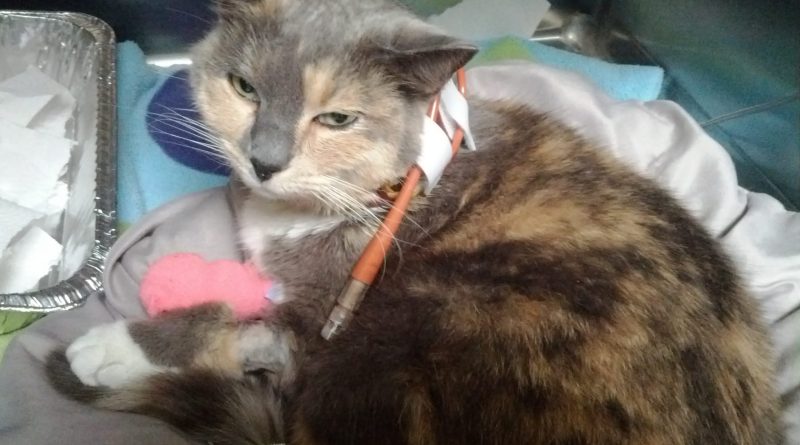Treatment of Hepatic Lipidosis in Cats
You may have heard that cats can get a serious liver disease if they stop eating for more than a few days. This condition is called “hepatic lipidosis” or “fatty liver” and is most common in overweight cats, although it can occur in any cat. When a cat doesn’t eat enough food for multiple days to weeks, because he has an illness that affects his appetite, because he doesn’t like his food, becomes overly stressed, or gets lost or trapped without access to food, his body starts using fat for energy. If food isn’t provided in time, the fat can overwhelm the cat’s ability to break it down. The fat will then build up in the liver until it causes serious liver disease. As overweight cats have more fat to move into the liver, they are at higher risk.
Cats with hepatic lipidosis are often depressed and dehydrated, may vomit or drool, and may have a yellow tint to their eyes and skin (jaundice). If you notice any of these symptoms, your cat needs to see a veterinarian immediately! Regardless of the underlying cause for the cat not eating, hepatic lipidosis can be potentially life-threatening on its own. Once the condition is confirmed, often by taking a sample of the liver with a needle, and the possibility of underlying diseases is investigated, then the most important steps to treat hepatic lipidosis are correcting dehydration and nutrient deficiencies and providing adequate calories to stop the breakdown of additional body fat stores.
As cats with hepatic lipidosis have it because they haven’t been eating enough (or at all) and the condition can make them feel nauseated, most cats with this condition won’t eat on their own. Therefore, they require a feeding tube in order to get adequate calories and nutrients into them to allow for the fat in their livers to be broken down and their liver hopefully restored to normal function. Cats may also require injectable supplementation of various nutrients like B vitamins, potassium, and vitamin K. Occasionally, in severe cases, cats with hepatic lipidosis require intravenous nutrition initially until they can tolerate nutrition through a feeding tube.
Introduction of food to cats with hepatic lipidosis should be initiated slowly and the amount of food increased to normal amounts over the course of several days. Slow feeding allows the cat to adjust and start to shift her metabolism away from using her own fat stores. As she get more nutrients from food, the fat can be slowly moved out of her liver through normal metabolic processes. Many cats with hepatic lipidosis will need a feeding tube for several weeks, some for even longer, until they are willing and able to eat an appropriate amount of food to maintain weight without the tube.
Therefore, long-term feeding tubes (esophagostomy or gastrostomy tubes) that can be used at home are recommended rather than the smaller nasal feeding tubes (nasogastric or nasoesophageal) that are sometimes used short-term in hospitalized cats. It can be really exciting when a cat with hepatic lipidosis starts eating well again on its own, but it is important to not get impatient and remove the tube too soon! It should stay in for at least a week after the cat starts eating enough food on her own to maintain weight.
Many cats with hepatic lipidosis who are treated aggressively with feeding tubes will recover. However, the prognosis for cats with underlying health issues will be dependent on the management of those issues. For example, if a cat stopped eating because he has chronic gastrointestinal disease, such as inflammatory bowel disease, that condition will need to be managed to keep him eating well in the future. After cats with lipidosis start eating on their own again and the feeding tube is removed, their food intake should be carefully monitored so intervention can take place if they start to eat less to prevent another episode of hepatic lipidosis.
For overweight cats that have recovered from hepatic lipidosis, the risk of another episode can be reduced by completing a closely supervised weight loss plan. For cats that developed hepatic lipidosis because of underlying health issues, a change in diet after the tube is removed may be helpful to control the underlying health concerns. Many health conditions can benefit from the use of therapeutic diets with modified nutrient profiles and other properties.
Although many cats can recover from hepatic lipidosis if it’s caught early enough, it is a serious disease that requires long-term care and nutritional support. Therefore, prevention is very important! Some strategies for preventing hepatic lipidosis include monitoring your cat’s weight regularly (consider buying your own baby or pet scale), weight loss for an overweight cat, feeding a measured amount of food and monitoring how much is eaten, minimizing stress , making changes in diet very gradually, and taking your cat for regular veterinary care, especially if you notice changes in behavior, weight, or food intake.

